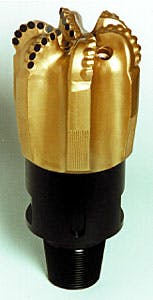Nelson Emery,
Dennis Romero,
Tony Lilburn
Spirit Energy 76
Tom Claus,
Greg Hull
Baker Hughes
Inteq
This Hughes Christensen HCC TX445, 81/2-in. PDC bit has been specially designed for use with the rotary closed-loop drilling system. Empirical tests show that a long tandem gauge and a limited side-cutting action improve steerability (Fig. 3).
A rotary steerable system penetrated a complex configuration of geologic targets, providing evidence that this technology may someday replace conventional geosteering technologies for many applications.
Spirit Energy 76 (a business unit of Unocal Corp.) and Vastar Resources Inc. conducted a trial of Baker Hughes Inteq's AutoTrak rotary closed-loop drilling system (RCLS) last August in the exploratory well P.R. Norman No. B-4, located in the East Lake Palourde field, La.
This became the first field application of the RCLS in the Western Hemisphere. The RCLS's ability to continuously rotate, aided by automated steering and two-way communications, held promise because the system had been successfully applied in similar applications in the North Sea and Europe during the latter part of 1997.
The system overcame a combination of formation problems and a multiple target well profile that was not economically feasible using conventional directional drilling methods. The challenge in this field was to directionally drill the well with precision, penetrate five targets, and remain within the estimated well cost.
Geologic complexity
Newly obtained 3D seismic detailed the complex fault pattern. Middle Miocene pay intervals in this field range in depths of 10,000-16,000 ft. Since 1954, the field has produced 780 bcf of gas and 34 million bbl of oil and condensate.The well plan, as shown in Fig. 1 [176,108 bytes], first involved penetrating the target horizons as structurally high as possible, near the intersection of two faults. Next, the well path was designed to deviate at a high enough angle to stay in front of the trailing fault.
Because the structurally highest points are close to two faults, this exploration process requires a high degree of well-path control. Wells of this deviation, at these depths, typically include a high mechanical risk and are costly and problematic. Until now, well designs of this nature were avoided in this field.
Spirit and Vastar approved the well with the assumption that this new technology would provide operating efficiencies and performance benefits as compared to conventional assemblies that would drive up well costs due to slow penetration rates and frequent trips.
Top-hole section
Prior to picking up the RCLS, conventional directional drilling tools were used to "nudge," or kick the well off. Using an oil-based mud system, the top-hole section was designed to align the well path with multiple targets. This required an S-curve consisting of a build to 19.5°, starting at 8,450 ft, then dropping back to near vertical.What was thought to be an easy procedure using a conventional steerable motor and measurement-while-drilling (MWD) assembly turned out to be a long exercise. Steady tool-face orientations using a heavy-set polycrystalline diamond compact (PDC) bit proved unmanageable.
An extra trip was made to pick up a less-aggressive PDC bit. This bit trip was necessary to reach a depth where a repeat formation test (RFT) log could confirm depleted sandstone formation pressures. Holding a steady tool face to perform the planned drop to vertical proved to be both frustrating and time consuming, even with the less-aggressive PDC bit.
Closed loop
The RCLS was then prepared by connecting electronics and related modular surface sensors (MSS II) to the computer systems in the control cabin. The term "rotary closed loop system" refers to the way information is handled. A downhole closed loop controls steering vectors and target inclination. This works in conjunction with the mud-pulse telemetry from downhole and a surface-to-tool communications closed loop.Because it is no longer necessary to monitor standpipe pressure as required while drilling with a downhole motor, directional drillers using this system work in the cabin rather than on the rig floor. The surface computer system recalculates well plans after each new survey.
Meanwhile, MWD personnel maintain the system operating software, continuously acquiring and interpreting downhole data. In this operating environment, a close synergy develops between the MWD operators and the directional drillers.
The system combines proven technologies with two new concepts, enabling 3D changes in hole trajectory while drilling in the rotary mode. Unique to the system is the nonrotating steerable stabilizer and by-pass actuator.
The nonrotating steerable stabilizer, which is decoupled from the drillstring rotation, has a drive shaft that rotates within the nonrotating sleeve (Fig. 2 [84,421 bytes]). Components in the stabilizer housing include a near-bit inclinometer, steering control electronics, and control valves that hydraulically operate three steering ribs.
The position of the sleeve, which has a tendency to rotate very slowly, is continuously monitored. The system uses information from the downhole instrumentation to adjust the force applied to the formation by each steering rib, providing a steady side force at the bit in the desired direction.
An internal microprocessor calculates pressure to be applied to each piston, moving the steering ribs so that the tool face is oriented in the correct direction (OGJ, Mar. 2, 1998, p. 65). The magnitude of the force applied to the steering ribs also takes into account dogleg limits that have been set for the hole section being drilled.
The bit side force and its direction equates to a high-side tool face and controls the occurrence of the dogleg severity.
Downlinking
Downhole communications with the tool, otherwise known as "downlinking," is controlled by the surface computer system through a bypass actuator installed near the standpipe. The bypass actuator provides a means for two-way communications. The mud-pulse telemetry transmits data from the tool while the bypass actuator allows reprogramming of target inclination, steering-rib forces, formation evaluation data-telemetry formats, and data-memory management.The bypass actuator is connected to the standpipe. The bypass actuator diverts about 15% of the flow during a downlink. A computer-controlled diamond disk valve opens and closes, sending a coded signal down to the tool. Downhole, the tool senses flow modulation and decodes the downlink commands.
A complete downlink command takes 2-8 min, depending upon the number of variables and instructions. This automated method of downlinked communications can be maintained while drilling, allowing control of the well path without interrupting drilling activities. Confirmation of all new downlinked command reprogramming is telemetered back to the surface.
Prior to each run, tests verify that there are no problems with communications followed by tool memory inititialization. Further shallow hole tests at about 1,000 ft ensure correct drilling fluid flow rates and standpipe pressure while positive downlink tests make sure that commands (steering target changes) will be recognized and decoded.
Continuous rotation
As compared to slide drilling (drilling without rotation), continuous rotation alone is believed to improve penetration rates by as much as 50%. Continuous drillstring rotation helps to suspend drill cuttings, which positively affects hole-cleaning properties and minimizes drillpipe-to-borehole friction.In many cases, rock bits have been run with steerable motors because PDC bits create high-reactive torque that can disrupt toolface orientation. With the RCLS system, bit selection can now be made according to formation drillability rather than steerability.
Typically, PDC bits outlast rock bits, yielding more time spent on bottom and drilling. The need for oil-based muds to overcome borehole/bottom hole assembly friction is reduced, so water-based fluids can be used instead of the more costly oil-based mud. This can result in fewer wiper trips and circulating operations, fewer stuck-pipe incidents, fewer washout conditions, and lower equivalent circulating densities.
The system produces an in-gauge hole and eliminates transition ledges and hole spiraling. The clean well-bore profile enables complex well profiles and can extend the reach of horizontal wells. Real-time monitoring of drilling dynamics further improves drilling efficiency.
Since the RCLS replaces conventional motors with a much shorter steering unit, the resistivity and gamma measurements are made just 16 ft above the bit as compared to 30 ft and longer. For the type of well profile constructed in well No. B4, the system provides early lithologic evaluation, enhanced pore pressure detection, and precise control relative to the plan.
Off-bottom directional surveys, taken closer to the bit, measure azimuth and inclination. All runs for the Spirit Energy well incorporated the system's reservoir navigation tool (RNT). The RNT incorporates multiple propagation resistivity (MPR) and Gamma Ray (GR) measurements to enable real-time geosteering, and can be run with drilling dynamic and annular pressure sensors along with compensated bulk density and neutron porosity subs.
Nudge, turn, and build
For well No. B-4, the RCLS tool was picked up at 12,195 ft measured depth (MD) to complete the vertical nudge section. It easily turned the well 90° while keeping the inclination steady at 7° in order to line up the targets before building inclination.This was done by downlinking a target inclination of 7° and other steering commands to the tool. Using a conventional steerable mud motor-MWD assembly, performing directional work below 10° is usually difficult at best, even with rock bits.
The significance of this capability is profound for two reasons. Penetration rates would have been sorely compromised with a conventional BHA, and would have necessitated at least one rock bit run with penetration rates less than 5 ft/hr.
Also, having the ability to replan the well path during drilling activities and to steer the well path helped eliminate the potential for costly plugging back and sidetracking operations. The RCLS's continuous and automated steering made it possible to use a custom-designed Hughes Christensen PDC bit (Fig. 3).
This bit was designed specifically for directional drilling with the RCLS system. Its cutter design and inner cone back rake provided dynamic stability while developing high penetration rates, greatly reducing bit whirl and lateral vibrations.
The well was drilled at about 20-25 ft/hr through the turn and immediately began the build to 54° at the same penetration rate. The turn and build were finished in one run and the tangent section was begun. During this operation, however, the steering sleeve, normally a nonrotating component that serves as a receptacle for the self-adjusting steering ribs, began to rotate, prohibiting further directional control.
Nevertheless, drilling continued another 10 hr until the tool failed to transmit mud pulses, resulting in a trip for another tool. Drilling resumed with the inclination held at 54° and the azimuth lined up to hit the remaining targets.
The tightly cemented Miocene sands in this well tended to slightly attenuate the dogleg severity achievable with RCLS steering. By downlinking commands, adjustments were made to the steering ribs in order to construct a smooth well path.
Well plans with dogleg severities up to 6.5°/100 ft can be negotiated with the system, although this well was planned with a build rate of 3°. Fifty downlinks were made throughout the RCLS section, with a recognition accuracy of 100%.
Near the end of this section, Spirit decided that the bit had been severely dulled while drilling the tightly cemented, partially depleted sandy formations. The dullness of the bit was reflected as a slower penetration rate.
The RCLS tool was operating as expected when it came time to pull the assembly. The bit was found to be "ringed out" and worn, having accumulated nearly 165 on-bottom drilling hours.
Final hole section
The final section of the well was drilled with a conventional MWD tool and steerable motor assembly. The tool was used to simultaneously ream and log two intervals. Drilling then continued to a TD of 16,017 ft (4,882 m) MD.The wire line contractor predicted that hole inclination and length would require tubing-conveyed logging procedures. Some problems were experienced while running the tool string in the hole.
A ledge was tagged at 11,131 ft with a 4° dogleg, developed from the steerable motor run during the nudge section described above. This created cause for concern. However, once past this spot, the tools smoothly traversed across the sections drilled by RCLS throughout the turn and build section of the well.
There were several doglegs above 4° through this interval, but no other tight spots were encountered until 15,450 ft. The 57° hole angle at this depth was drilled with a conventional steerable mud-motor assembly. With only wet sands below this depth, the wire line tool was pulled out of the hole, logging the objectives with an in-gauge hole.
Prior to running casing, a hole opener was run but became stuck in the hole below the pay. The string was free-pointed and backed off, then cemented in the hole. Casing was then run in the hole and went to bottom above the fish, yet below all of the pay intervals.
Overall results
Overall drilling performance greatly improved field economics by executing the well objective as planned by penetrating all of the targets. What began as a technology test in a low-cost application turned out to be a rejuvenation of a mature field.This has shed new light on the overall field reserves. The well, planned with the savings of AutoTrak RCLS built into the original AFE (authority for expenditure), came within estimated drilling costs. The best offset in the field, a vertical well, required nine rock bits to drill the comparable section. The rotary steerable system drilled this same interval in three runs using one HCC TX445 PDC bit (Fig. 4 [89,357 bytes]).
The three RCLS assemblies drilled 3,106 ft (947 m) runs 4, 5, and 6 in 164.7 drilling hours, averaging 18.9 ft/hr (5.8 m/hr) to a depth of 15,301 ft (4,664 m) MD. This performance was twice as fast as the best offset in the entire field.
The rotary steerable system shaved 8 days off the drilling time of the best previous well in the field. In comparing the 81/2-in. interval to the offset wells, a savings of over $550,000 was achieved. In addition, an estimated 190 net ft of pay was discovered in the secondary targets of this well.
Other benefits for the East Lake Palourde field clearly exist in using this new technology. Directional wells can now be drilled to hit multiple targets, thus rejuvenating the field and making it economically feasible to intersect more target horizons with fewer wells.
Spirit can now also drill longer production hole intervals and eliminate casing strings. With cleaner and smoother well bores obtained by continuous rotary drilling, stuck pipe occurrences should be minimized and successful placement of production casing strings to bottom should become more likely.
New wells, not possible before, can now be planned in this field using RCLS technology.
Acknowledgment
The authors thank Spirit Energy 76 and Baker Hughes Inteq for permission to publish this information.The Authors
Nelson Emery is a drilling superintendent for Spirit Energy 76, a division of Unocal. He attended the University of Southwestern Louisiana, majoring in physical education, entering the oil field with drilling contractors in 1965. He spent 6 years as a directional driller along the Gulf Coast and then joined Unocal in 1978 as a drilling foreman. He served as a senior drilling foreman with Spirit prior to his assignment as a drilling superintendent in 1997.
Dennis Romero is a senior advising drilling engineer for Spirit Energy 76, a division of Unocal. He attended the University of Southwestern Louisiana and earned a BS degree in petroleum engineering in May 1970. Romero has worked in the Gulf Coast Region for Unocal and has 9 years' production and 19 years' drilling experience.
Tony Lilburn is a geologist for Spirit Energy 76 in Lafayette, La. His current responsibilities include the development and exploration of five fields in South Louisiana, Texas, and Michigan. He has been in his current assignment for 7 years. Prior to that, Lilburn was an exploration geologist in Unocal Corp.'s Oklahoma City office. He holds a BS and MS in geology from Oklahoma State University.
Tom Claus is a Gulf Coast region AutoTrak manager for Baker Hughes Inc. He has been with Baker since 1985 and has held positions as an account manager, technical support engineer, and MWD supervisor. He holds a BS in geology from West Virginia University.
Greg Hull is a directional drilling operations engineer with Baker Hughes Inteq. He presently works in-house at Spirit Energy 76, Lafayette, La. Hull joined Eastman Christensen in Bakersfield, Calif., in 1990 and has held various Operations positions in Corpus Christi, Tex., and New Orleans. He holds a BS in petroleum engineering from Montana Tech.
Copyright 1999 Oil & Gas Journal. All Rights Reserved.








